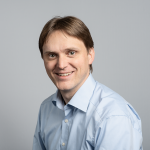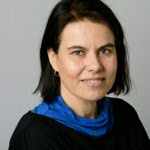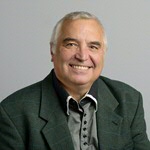Advent calendar - December 24th - Zernike Institute Papers of the Year 2021
In the Zernike Institute Advent Calendar, we are presenting 24 short spotlights in December. In these specials, we highlight PhD students, postdocs, and technicians of our research groups - providing a glimpse into their typical day at work. In Episode 24 - the final one - we are deviating from this for a second time and provide our handpicked Best of 2021 Publications - the personal research highlights of our principal investigators. We provide them together with a short summary on what makes the publication a special one. Enjoy the selection, enjoy the science, learn something new, stay curious and most importantly: stay safe, stay healthy and enjoy the holiday season and all the best for 2022!
The principal investigators are listed in alphabetcial order
Use ctrl+f (Windows)/ cmd+f (Mac) to search for keywords of your interest

Coexistence of different magnetic ordering in thin films of SrMnO3 studied by spin transport | A. Das, V. Eswara Phanindra, A. J. Watson, and T. Banerjee | Antiferromagnets are rapidly evolving as a league of their own in spintronics. In this regard, material choice that offers tunability of magnetic ordering and flexibility in device design are key to further developments. This work is a first study that exploits the rich landscape inherent to correlated oxides by employing SrMnO3, an end member of the manganite family and a multiferroic material. Using all electrical transport schemes such as Spin Hall Magnetoresistance (SMR) and Spin Seebeck Effect (SSE), the work demonstrates a spatially varying magnetic ordering from a ferromagnetic to an antiferromagnetic superexchange. SSE reveals fingerprints of magnon-phonon interaction across the surface and bulk of the films. This work not only highlights the versatility of correlated oxides as a strong candidate in antiferromagnet spintronics but also establishes new routes to study electric field control of magnon spin transport in multiferroics for alternative computing strategies.

Polar structure and two-dimensional Heisenberg antiferromagnetic properties of arylamine-based manganese chloride layered organic-inorganic perovskites | L. Septiany, D. Tulip, M. Chislov, J. Baas, and G.R. Blake | Here we propose a general mechanism by which inversion symmetry can be broken in layered halide perovskites. The breaking of inversion symmetry might lead to improved performance in photovoltaic and optoelectronic devices, as well as a possible new class of ferroelectric materials.

An Event-Based Digital Time Difference Encoder Model Implementation for Neuromorphic Systems | Daniel Gutierrez-Galan, Thorben Schoepe, Juan Pedro Dominguez-Morales, Angel Jimenez-Fernandez, E. Chicca, Alejandro Linares-Barranco | In this paper Thorben Schoepe and Elisabetta Chicca alongside colleagues from the University of Seville, Spain, present a novel FPGA implementation of the time difference encoder (TDE), a model for temporal coding of event-based signals. The model originally proposed by the Bio-Inspired Circuits and Systems group is a useful tool to explore spatiotemporal dynamics in spiking neural networks. It has been implemented as a digital circuit on FPGA. It allows a configurable time constant, enabling it to be used in a wide range of sensing tasks that require the encoding of the time difference between events, such as optical flow-based obstacle avoidance, sound source localization, and gas source localization.

Influence of the crystal packing in singlet fission: one step beyond the gas phase approximation | Luis Enrique Aguilar Suarez, Coen de Graaf and Shirin Faraji | In this paper the theoretical chemists at Zernike, for the first time, go beyond gas phase dimer model to study singlet fission, a multiexciton generation process, that has the potential to enhance the performance of solar cells. Our results highlights that the character of the excites states and the corresponding electronic couplings depend strongly both on the relative orientation of the dimmers within the crystal as well as and the electrostatic effect of the surrounding crystal. The paper was recognised by the editor as PCCP HOT Article and offered the PCCP front cover.

Tuning star architecture to control mechanical properties and impact resistance of polymer thin films | Andrea Giuntoli & Sinan Keten | This paper shows nicely how coarse-grained molecular dynamics simulations can be used to determine the macroscopic response of polymer materials from their nanoscale structure, bridging the gap between theory and applications and accelerating material design.

Interfacial Spin-Orbit Torques and Magnetic Anisotropy in WSe2/Permall oy Bilayers | Jan Hidding, Sytze H. Tirion, Jamo Momand, Alexey Kaverzin, Maxim Mostovoy, Bart J. van Wees, Bart J. Kooi, and Marcos H. D. Guimarães | I was selected as one of the "IOP Emerging Leaders in Materials" and this is the paper for the special edition of the journal. I also believe this work nicely illustrates the active and collaborative environment at Zernike. It involved the collaboration between my group and 3 others: Maxim Mostovoy (theory), Bart van Wees (device preparation), and Bart Kooi (TEM imaging).

The electronic structure of carbones revealed: insights from valence bond theory | Remco W. A. Havenith, Ana V. Cunha, Johannes E. M. N. Klein, Francesca Perolari, Xintao Feng | In this paper we studied the peculiar C=CO bond in carbonsuboxide and related compounds. The nature of the bond in this compound has been a long topic of discussion. We settled this issue and give a description of this bond in terns of covalent and ionic contributions.

All-optical manipulation of singlet exciton transport in individual supramolecular nanostructures by triplet gating | Bernd Wittmann, Till Biskup, Klaus Kreger, Jürgen Köhler, Hans-Werner Schmidt and Richard Hildner | In this paper we demonstrate control of excitons by excitons. We use stationary, long-lived triplet excitons to steer mobile, short-lived singlet excitons in single organic supramolecular nanostructures. We were able to resolve the singlet exciton motion with nanometre precision on nanosecond time scales.

Computational Spectroscopy of Complex Systems | Thomas La Cour Jansen | The paper gives on overview of how one can simulate spectroscopic observables and interpret the underlying physics, structure, and function of complex systems as proteins, and artificial and natural light-harvesting systems. The paper made the cover of J. Phys. Chem.

Responsive Pickering Emulsions Stabilized by Frozen Complex Coacervate Core Micelles | Julien Es Sayed, Hugo Brummer, Marc C. A. Stuart, Nicolas Sanson, Patrick Perrin, and Marleen Kamperman | For the Polymer Science group this paper is a highlight, because it is the first scientific publication with experimental work performed in Groningen (the group was established in Sept 2018). It describes a new way to stabilize Pickering emulsions in a reversible manner using complex coacervate core micelles.

Strain Relaxation in “2D/2D and 2D/3D Systems”: Highly Textured Mica/Bi2Te3, Sb2Te3/Bi2Te3, and Bi2Te3/GeTe Heterostructures | Heng Zhang, Daniel T Yimam, Sytze de Graaf, Jamo Momand, Paul A Vermeulen, Yingfen Wei, Beatriz Noheda, Bart J Kooi | Strain in thin films and heterostructures can markedly affect their functional properties. In this work we show, using four independent techniques, that a novel type of long range exponentially decaying (LRED) strain in heterostructures of Sb2Te3, Bi2Te3 and GeTe is the result of the pseudo two-dimensional nature of the materials based on layers with strong intralayer and weak interlayer atomic bonding. The LRED strain occurs due to gradual plastic relaxation and is not the result of an elastic (energy minimization) process as was recently proposed.

Revealing Charge Carrier Mobility and Defect Densities in Metal Halide Perovskites via Space-Charge-Limited Current Measurements | V.M. Le Corre, E.A. Duijnstee, O. El Tambouli, J.M. Ball, H.J. Snaith, J. Lim, and L.J.A. Koster | The literature on perovskite solar cells is littered with papers that apply basic space-charge-limited current (SCLC) measurements to try to quantify the number of traps. However, quite often the SCLC theory is applied incorrectly and hysteresis is simply ignored. In this paper, we show how to correctly apply this measurement technique and how, through numerical modelling, the mobility and defect densities can be extracted. It was listed in ACS Energy Letters most read articles of the month (April 2021).

Scalable, Template Driven Formation of Highly Crystalline Lead-Tin Halide Perovskite Films | Jun Xi, Herman Duim, Matteo Pitaro, Kushagra Gahlot, Jingjin Dong, Giuseppe Portale, Maria Antonietta Loi | One of the challenges of making solar cells with metal halide perovskites, is the deposition of highly crystalline films in a large scale. In this article we demonstrate that we can transform an highly crystalline and oriented 2D material (PEA)2(Pb0.5Sn0.5)I4 deposited with a scalable technique (blade coating) in a three dimensional material FA(Pb0.5Sn0.5)I3. While the 2D system is not very useful to make solar cells due to the electron confinement in two dimensions, the three dimensional system is highly suitable for the fabrication of solar cells, but its crystallisation is rather slow and high quality films with scalable techniques are very difficult to obtain. The advantage of this transformation (ligand exchange) is that the high orientation and the crystalline nature of the 2D films is retaining opening the way to the large scale deposition of this very interesting material and their use in the fabrication of solar cells.

Robust Superamphiphilic Membrane with a Closed-loop Life Cycle | Ye, C.; Voet, V. S. D.; Folkersma, R.; Loos, K. | The Loos group, together with researchers of NHL Stenden, developed a novel biobased vitrimer system for oil spill recovery. Spilled oil poses serious threats to freshwater and marine environments. Cleaning up an oil spill in water is quite a challenge. Superamphiphilic membranes, that 'love' both oil and water, are a promising solution but not yet a very practical one. These membranes are often not robust enough for usage outside the laboratory environment, for the membrane pores can clog up because of fouling by algae and sand. The research team around Katja Loos used a novel type of bio-based polymers to create a membrane that is both strong and easy to recycle.

Magnetic particles and strings in iron langasite | Evgenii Barts & Maxim Mostovoy | In this paper we predict a new magnetic particle-like defect in a realistic material. Topological magnetic defects, such as domain walls, vortices and skyrmions, are stable and mobile, and can be used as information bits in magnetic memory devices. However, all of them are extended objects in one or two spatial dimensions: skyrmions and vortices are actually strings, the domain wall is a sheet, which hinders their motion through imperfections in magnetic materials and limits the number of directions in which they can move. The defect that we predict is particle-like -- it has a final spatial extent in all three directions. This magnetic particle is closely related to topological defects studied in high-energy physics and superfluid helium.

Reversible oxygen migration and phase transitions in hafnia-based ferroelectric devices | Nukala, P., Ahmadi, M., Wei, Y., Graaf, S. D., Stylianidis, E., Chakrabortty, T., Matzen, S., Zandbergen, H. W., Björling, A., Mannix, D., Carbone, D., Kooi, B. & Noheda, B. | Ferroelectric hafnia-based devices allow for the first time to stabilize a polar material at the nanoscale and promise to enable low-power non-volatile RAM memory and brain-inspired computation. How the polarization switching takes place is not fully understood. This paper reports operando experiments under the transmission electron microscope that allow following the atomic shift and, most impressively, the migration of oxygen that take place in a layer of a couple of nanometers under the application of the electric field. Oxygen migration plays a key role in the ferroelectric switching.

Spherulitic and rotational crystal growth of Quartz thin films | Nick R. Lutjes, Silang Zhou, Jordi Antoja-Lleonart, Beatriz Noheda & Václav Ocelík | Very detailed analysis by Electron Back-Scatter diffraction allows to discover, why thin films of SiO2 and GeO2 crystallize in the form of spherulites containing rotational crystals. The role of specific dislocations formed on the glass/crystal interface during the crystallization has been clearly disclosed.

Ultra-Low-Density Digitally Architected Carbon with a Strutted Tube-in-Tube Structure | Jianchao Ye, Ling Liu, James Oakdale, Joseph Lefebvre, Sanjit Bhowmick, Thomas Voisin, John D. Roehling, William L. Smith, Maira R. Cerón, Jip van Ham, Leonardus Bimo Bayu Aji, Monika M. Biener, Y. Morris Wang, Patrick R. Onck, Juergen Biener | This paper is the result of a long-lasting collaboration with researchers from Lawrence Livermore National Laboratory in the US that started by accident during the coffee break of a conference. They were puzzled by their experimental data of a highly-porous carbon-based material that seemed to retain almost all of its strength with decreasing density and they asked our advise. Back in Groningen, bachelor student Jip van Ham and PhD student Ling Liu started to work on it and we found that nanostruts linking the inner and outer tubes of the double-tube sandwich-structures were key in explaining the unexpected behaviour. The results open an exciting new design pathway by applying similar techniques to 3D-printed lattice structures which is expected to result in an even better mechanical performance.

Diffusion-enhanced exciton dissociation in single-material organic solar cells | Nong V Hoang, Vasileios C Nikolis, Lukasz Baisinger, Koen Vandewal, Maxim S Pshenichnikov | The oldest organic photovoltaic solar cell design, based on a single-material active layer, demonstrates surprisingly high quantum efficiency of charge generation — almost 50%. How exactly this is realized, had remained an open question until our paper was published. Our findings directly contribute to the understanding of exciton dissociation in single-material devices but might also be applicable to modern non-fullerene based organic solar cells.

Revisiting the Mechanism of the Meso-to-α Transition of Isotactic Polypropylene and Ethylene–Propylene Random Copolymers | Federico Di Sacco, Sarah Saidi, Daniel Hermida-Merino, and Giuseppe Portale | The mechanism of transition between the disordered mesomorphic phase and the ordered monoclinic alpha phase in polypropylene-based systems has been investigated for the first time using a simultaneous combination of X-ray scattering (SAXS/WAXS) and Raman spectroscopy. The differences in the mechanism of transition between the homopolymer and the random copolymer containing ethylene counits are highlighted. In particular, the ethylene counits suppress the steps of chains interlock and subsequent ordered chain elongation, characteristic for the iPP homopolymer. Despite this suppression, the transition still occurs, but with a significant incorporation of defects inside the crystals for the random copolymer. What makes it special: This work is unique as it provides a complete picture of the structural transition only possible by combination of multiple techniques. X-rays are highly sensitive to the degree of order among the polymer chains while Raman is extremely sensitive to the local chain conformation. Moreover, the used experimental approach is unique and challenging, developed in the framework of this PhD project at the European Synchrotron Radiation Facility. The scientific question tackled here was unknown so far and very important in the field of polymer crystallization on the second most produced polymer worldwide.

Colloidal nano-MOFs nucleate and stabilize ultra-small quantum dots of lead bromide perovskites | Loredana Protesescu, Joaquín Calbo, Kristopher Williams, William Tisdale, Aron Walsh and Mircea Dincă | The marriage between the perovskites and MOFs, two functional nanomaterials has been successfully achieved within the collaboration between dr. Loredana Protesescu (Nanomaterials chemistry ZIAM) and Prof. Mircea Dincă (MIT). Merging the two experts' expertise, they demonstrate a simple and effective host-guest strategy for preparing heterostructured nanocrystals. Ultra-small lead bromide perovskite quantum dots were obtained through the use of nano-sized MOFs that function as nucleating and host sites.

Virus self-assembly proceeds through contact-rich energy minima | Buzón, P., Maity, S., Christodoulis, P., Wiertsema, M. J., Dunkelbarger, S., Kim, C., Wuite, G. J. L., Zlotnick, A. & Roos, W. H. | In this study we look at viral self-assembly with the complementary techniques optical tweezers and high-speed AFM and show that the first protein-protein contacts during assembly are driven by contact maximization.

Synthesis of 2D germanane (GeH): a new, fast and facile approach | Giousis, T., Potsi, G., Kouloumpis, A., Spyrou, K., Georgantas, Y., Chalmpes, N., Dimos, K., Antoniou, M-K., Papavassiliou, G., Bourlinos, A. B., Kim, H. J., Wadi, V. K. S., Alhassan, S., Ahmadi, M., Kooi, B. J., Blake, G., Balazs, D. M., Loi, M. A., Gournis, D. & Rudolf, P. | This paper demonstrates a much shorter synthesis procedure for germanane making this novel two-dimensional material much more suitable for practical applications. I have chosen it not only for its scientific importance but also because it is a beautiful example on how we bring together different expertises within the Zernike Institute to make our research outcomes more complete and comprehensive.

Charge reversing multiple electron detachment Auger decay of inner-shell vacancies in gas-phase deprotonated DNA | Wen Li, Oksana Kavatsyuk, Wessel Douma, Xin Wang, Ronnie Hoekstra, Dennis Mayer, Matthew Robinson, Markus Gühr, Mathieu Lalande, Marwa Abdelmouleh, Michal Ryszka, Jean Christophe Poully, Thomas Schlathölter | X-ray induced inner-shell ionization of DNA is a fundamental process in biological radiation damage and radiotherapy. As DNA in biological environments is usually negatively charged, we have studied soft X-ray photoabsorption in the doubly deprotonated gas-phase DNA. Auger decay accompanied by detachment of at least three electrons was found to be the dominating decay mechanism of the X-ray induced inner shell vacancy, leading to charge reversal of the anionic precursor and the formation of positively charged photofragment ions. The same process was observed in heavy ion collisions with DNA at Bragg-peak energies, where inner shell vacancies can be induced but with smaller cross sections. The finding that Auger decay of a single K-vacancy is followed by production of at least three low energy electrons instead of a single high energy electron has important consequences for DNA damage modelling in radiotherapy, because of the difference in electron mean free path. Most likely, secondary electron-induced DNA damage is more localized around the initial K-shell vacancy than previously thought which could give rise to more complex damage.

Transfer of large-scale two-dimensional semiconductors: challenges and developments | Adam J Watson, Wenbo Lu, Marcos H D Guimarães, and Meike Stöhr | This review provides a comprehensive overview of the various transfer techniques used to transfer 2D materials, in particular transition metal dichalcogenides (TMDs). It discusses process-related drawbacks as well as comments on the current state of transfer techniques for large area CVD grown TMDs and describes opportunities, also in view of industrial applications.

Manganese containing copper aluminate catalysts: Genesis of structures and active sites for hydrogenation of aldehydes | Christoph Dörfelt, Michelle Hammerton, David Martin, Alexander Wellmann, Clara C. Aletsee, Moniek Tromp, Klaus Köhler | The paper describes the complex puzzle revealing reaction mechanisms in catalysis. The combination of advanced (operando) spectroscopy with catalytic studies has provided insights in the roles of the different catalyst components as well as the detailed mechanism. Moreover, the systems are important for industry, replacing the potentially toxic Cu/Cr spicel catalyst, with a sustainable Cu-only analogue. At the same time this tour-de-force study by Michelle and Christophe provides novel fundamental insights in the behaviour of spinel systems under reducing atmospheres.

Electrical and thermal generation of spin currents by magnetic bilayer graphene | Talieh S. Ghiasi, Alexey A. Kaverzin, Avalon H. Dismukes, Dennis K. de Wal, Xavier Roy & Bart J. van Wees | This paper is part of the thesis of Talieh Ghiasi, who defended her thesis cum laude this year. It describes a breakthrough in two dimensional spintronics and shows that graphene can actually be made magnetic by the proximity of a two dimensional magnetic semiconductor. This opens up news avenues for both fundamental studies of highly spin polarized two-dimensional electron gases as well, as for new device functionalities based on heterostructures of VanderWaals materials.

Hyperfine-mediated transitions between electronic spin-1/2 levels of transition metal defects in SiC | Carmem M. Gilardoni, Irina Ion, Freddie Hendriks, Michael Trupke, Caspar H. van der Wal | This paper answers what seemed a contradiction or point of confusion in the field that studies the stability of electronic spin at crystal defects. Some rules that point to stable cases seemed to forbid direct magnetic microwave driving of spin, contradicting experiments. This paper showed why both can be true, that it relies on a role for the nuclear spin of the defect, and discovered thereby also a new mechanism for microwave driving with the electric-field component.

Regulatory inter-domain interactions influence Hsp70 recruitment to the DnaJB8 chaperone | Bryan D. Ryder, Irina Matlahov, Sofia Bali, Jaime Vaquer-Alicea, Patrick C. A. van der Wel & Lukasz A. Joachimiak | I really like this study, as it started with surprising new ssNMR data (and some serendipity) leading us to speculate about a possible molecular mechanism, which then was validated by an array of other experiments and simulations. Combined this turned into a very nice multidisciplinary paper that provides new understanding of how oligomeric proteins control their own activity in the cell.

Intraoperative imaging in pathology-assisted surgery | Floris J. Voskuil, Jasper Vonk, Bert van der Vegt, Schelto Kruijff, Vasilis Ntziachristos, Pieter J. van der Zaag, Max J. H. Witjes & Gooitzen M. van Dam | My motivation for selecting this paper is that: It outlines the work I plan to be doing at the collaboration between Zernike Institute and the UMCG. Nature Biomedical Engineering is an excellent journalm in the field. We finally managed to get this paper published this year, after a rather extraordinary review and editorial process (The paper was finally published one year after acceptance).
More news
-
15 September 2025
Successful visit to the UG by Rector of Institut Teknologi Bandung
